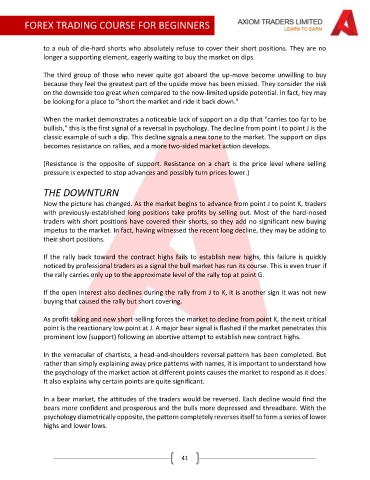Page 41 - NEW FOREX FULL COURSE
P. 41
FOREX TRADING COURSE FOR BEGINNERS
to a nub of die-hard shorts who absolutely refuse to cover their short positions. They are no
longer a supporting element, eagerly waiting to buy the market on dips.
The third group of those who never quite got aboard the up-move become unwilling to buy
because they feel the greatest part of the upside move has been missed. They consider the risk
on the downside too great when compared to the now-limited upside potential. In fact, hey may
be looking for a place to "short the market and ride it back down."
When the market demonstrates a noticeable lack of support on a dip that "carries too far to be
bullish," this is the first signal of a reversal in psychology. The decline from point I to point J is the
classic example of such a dip. This decline signals a new tone to the market. The support on dips
becomes resistance on rallies, and a more two-sided market action develops.
(Resistance is the opposite of support. Resistance on a chart is the price level where selling
pressure is expected to stop advances and possibly turn prices lower.)
THE DOWNTURN
Now the picture has changed. As the market begins to advance from point J to point K, traders
with previously-established long positions take profits by selling out. Most of the hard-nosed
traders with short positions have covered their shorts, so they add no significant new buying
impetus to the market. In fact, having witnessed the recent long decline, they may be adding to
their short positions.
If the rally back toward the contract highs fails to establish new highs, this failure is quickly
noticed by professional traders as a signal the bull market has run its course. This is even truer if
the rally carries only up to the approximate level of the rally top at point G.
If the open interest also declines during the rally from J to K, it is another sign it was not new
buying that caused the rally but short covering.
As profit-taking and new short-selling forces the market to decline from point K, the next critical
point is the reactionary low point at J. A major bear signal is flashed if the market penetrates this
prominent low (support) following an abortive attempt to establish new contract highs.
In the vernacular of chartists, a head-and-shoulders reversal pattern has been completed. But
rather than simply explaining away price patterns with names, it is important to understand how
the psychology of the market action at different points causes the market to respond as it does.
It also explains why certain points are quite significant.
In a bear market, the attitudes of the traders would be reversed. Each decline would find the
bears more confident and prosperous and the bulls more depressed and threadbare. With the
psychology diametrically opposite, the pattern completely reverses itself to form a series of lower
highs and lower lows.
41

